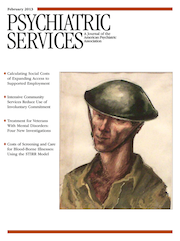This Month’s Highlights
Social Costs of Expanding Access to Supported Employment
The individual placement and support model of supported employment (IPS-SE) is an effective way to help people with serious mental illness get and keep jobs. However, access to IPS-SE services is currently very limited, and policy experts argue for greatly expanding service availability. This argument raises the question of whether such programs would pass a cost-effectiveness test in terms of social costs. In this month’s lead article, David Salkever, Ph.D., walks readers through a newly developed framework used by health economists to define and calculate the social costs of health programs. In simplest terms, an impact measure of social cost for an IPS-SE client is the difference between what the client consumes and what that individual produces. If IPS-SE increases the client’s earnings by more than it increases the dollar value of what the client consumes, then the social cost impact of IPS-SE is negative. To determine whether evidence on social cost impacts currently supports the argument for much broader access to IPS-SE services, Dr. Salkever applies this framework and the specific components of social cost impacts in a review of 27 IPS-SE studies conducted over the past two decades (page 111). In a Taking Issue commentary, Richard G. Frank, Ph.D., notes, “The story that emerges from Salkever’s article is a nuanced one. . . . Sometimes in health care we need to be satisfied with developing programs that simply make the lives of very sick people better at the same cost” (page 103).
Reducing Involuntary Commitments
For individuals experiencing a mental health crisis, involuntary inpatient hospitalization can be lifesaving—but also life disrupting for patients and their families. In Virginia, emergency evaluators employed by 40 statewide community service boards are the gatekeepers to involuntary commitment. To examine factors that play a role in decisions to initiate involuntary commitment, Elizabeth Lloyd McGarvey, Ed.D., and colleagues asked evaluators to complete a questionnaire after each evaluation. Data from more than 2,600 evaluations indicated that a lack of intensive community-based alternatives to hospitalization, such as temporary housing and voluntary residential or short-term crisis stabilization, was a significant predictor of the decision to initiate involuntary commitment. The findings provide “a sound empirical basis,” the authors note, for investing in a continuum of crisis stabilization services (page 120).
Focus on Veterans
Four studies in this issue examine services for veterans. Eric B. Elbogen, Ph.D., and colleagues looked at response data from post-9/11 veterans in the National Post-Deployment Adjustment Survey. Many studies of post-9/11 veterans have documented low rates of mental health service utilization. However, most studies looked at use in the first year postdeployment. In the sample studied by Dr. Elbogen and colleagues, the median time since deployment was four years. The sample had high rates of probable posttraumatic stress disorder (PTSD) and major depression; however, nearly two-thirds of these veterans reported past-year use of services. The finding of these notably higher rates is “a valuable message to communicate to veterans,” the authors conclude, and may reduce some veterans’ ambivalence about accessing care (page 134). Providing the best care for veterans with PTSD is a priority and a challenge. PTSD treatment guidelines developed by the U.S. Department of Veterans Affairs (VA) emphasize use of certain medications and discourage use of others. Thad E. Abrams, M.D., M.S., and colleagues analyzed prescriptions written by VA mental health providers and VA primary care providers for more than 350,000 veterans with PTSD. They found that providers continued to prescribe medications not supported by the guidelines and that the rates of inappropriate prescription were higher among mental health providers (page 142). The same VA research group sought to understand factors underlying benzodiazepine prescribing for veterans with PTSD despite guideline warnings. When Brian C. Lund, Pharm.D., and colleagues examined variation in prescribing practices across 137 VA facilities, they found that patient characteristics played a negligible role, but several facility characteristics were significant correlates of increased benzodiazepine prescribing (page 149). Finally, in a retrospective, ten-year study of nearly 6,000 veterans who had received VA substance abuse treatment, Jennifer L. Humensky, Ph.D., and colleagues found low rates of employment six months after treatment. Only 35% of the veterans reported having had paid work in the previous 30 days, and unemployment rates were especially high among those with comorbid anxiety and general medical conditions (page 177).



